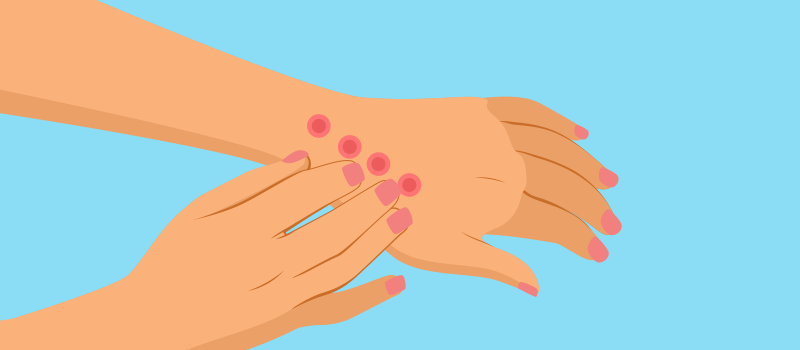What’s the Buzz
The Bee Healthy Blog
Porphyria Cutanea Tarda (PCT): Causes, Symptoms, & Treatments

Key Takeaways
-
Porphyria cutanea tarda (PCT) is a rare genetic disease that primarily affects the skin.
-
Symptoms of acute intermittent porphyria include abdominal pain, nausea, vomiting, paresthesias (numbness and tingling in the hands and feet), and seizures.
-
Porphyria cutanea tarda (PCT) can be triggered by excess iron, smoking, heavy alcohol consumption, estrogen, chronic hepatitis C, and human immunodeficiency virus (HIV).
-
It can cause cutaneous photosensitivity (increased sensitivity of the skin to sunlight) and painful, blistering skin lesions on the face and hands. The skin may also darken or thicken.
-
Treatment includes avoiding the underlying cause or triggering factors, phlebotomy to decrease iron and porphyrin levels in the liver, or taking a small dose of antimalarial drugs.
Porphyria cutanea tarda (PCT) belongs to a group of rare genetic diseases that primarily affect the skin. Please continue reading to learn more about PCT.
What is porphyria cutanea tarda (PCT)?
Porphyria cutanea tarda (PCT) is the most common form of porphyria. It mainly affects the skin.
Porphyria is a rare condition in which there is a buildup of natural substances called porphyrins in the body. Porphyrins are needed to make the heme in hemoglobin, the protein in red blood cells that carries oxygen to every tissue in the body.
Symptoms of acute intermittent porphyria include abdominal pain, nausea, vomiting, paresthesias (numbness and tingling in the hands and feet), and seizures.
What is the leading cause of porphyria?
Porphyria cutanea tarda is a complex condition with multiple causes, including genetic aspects and environmental susceptibility factors. If you have a family history of PCT, your healthcare provider will offer genetic counseling to help you understand the risks of passing the disorder to your offspring.
What triggers PCT?
Known triggers for porphyria cutanea tarda (PCT) include excess iron, smoking, heavy alcohol consumption, estrogen, chronic hepatitis C, and human immunodeficiency virus (HIV).
Genetic changes in the HFE gene (which is also associated with hemochromatosis or iron overload) can contribute to PCT.
In 25% of the cases, porphyria cutanea tarda runs in the family. This is called familial PCT and is linked to a deficiency in the UROD gene. The UROD deficiency causes an accumulation of porphyrins in liver cells. Familial PCT is inherited in an autosomal dominant pattern, meaning you develop the disorder if you inherit a single copy of the mutated gene from one parent.
What are the skin symptoms of porphyria cutanea tarda?
Most patients with porphyria cutanea tarda experience cutaneous photosensitivity (increased sensitivity of the skin to sunlight). This causes painful, blistering skin lesions in sun-exposed areas of the skin, such as the face and hands. The affected skin can be especially fragile and prone to skin infections. It can blister and peel in response to minor trauma. Some people have skin manifestations such as darkening or thickening of the affected skin and/or increased hair growth. These changes may be followed by gradual scarring and hypo- or hyperpigmentation (changes in skin color).
Can PCT cause liver damage, liver disease, or liver cancer?
People with porphyria cutanea tarda (PCT) are at an increased risk of developing problems in other organs besides the skin, especially the liver, due to the accumulation of porphyrins. Liver abnormalities associated with PCT can include liver cirrhosis and liver cancer.
Does PCT affect the eyes?
Possible symptoms of PCT can include eye involvement with ectropion (outward turning of the lid), lid scarring, pterygium (a growth on the conjunctiva), acute scleritis (inflammation of the sclera), scleral necrosis (death of the scleral tissue), corneal thinning, and corneal perforation. However, these complications are very rare.
How do doctors diagnose porphyria cutanea tarda?
Doctors can diagnose PCT based on the presence of elevated porphyrin levels in the stool. In people with the familial form of PCT, a confirmed diagnosis can be made from a deficiency of UROD genes in red blood cells.
The differential diagnosis for PCT includes other cutaneous porphyrias, such as variegate porphyria and hepatoerythropoietic porphyria. These other conditions occur due to different enzyme deficiencies. For example, variegate porphyria occurs due to a deficiency of the protoporphyrinogen oxidase (PPO) enzyme. A confirmed diagnosis of the PCT type can be made with laboratory tests. For instance, the presence of a characteristic fluorescence peak on plasma fluorometric scanning is seen in patients with variegate porphyria.
What is the treatment for elevated iron levels in PCT?
To treat porphyria cutanea tarda, your healthcare provider will recommend the following:
-
Avoid the underlying cause or triggering factors, such as alcohol consumption, smoking, intake of excess iron, or the use of estrogen-containing hormonal contraceptives.
-
Undergo phlebotomy to decrease iron and porphyrin levels in the liver. This is done by removing one unit of whole blood every 2 weeks until iron reaches normal levels.
-
Take a small dose of antimalarial drugs such as hydroxychloroquine or chloroquine if iron levels are not elevated and an HFE gene mutation is not present. Treatment may need to continue for 6-9 months to achieve complete remission. Contraindications to the use of these drugs include pregnancy, retinal disease, liver disease, and treatment with other drugs that are toxic to the liver.
-
Concomitant treatment of hepatitis C.
Iron chelation therapy is not usually recommended for people with porphyria cutanea tarda (PCT) due to iron overload because it is not as effective as phlebotomy and hydroxychloroquine and is expensive. However, medications such as deferoxamine and deferasirox may be used in people who cannot take hydroxychloroquine or undergo phlebotomy.
Is porphyria cutanea tarda life-threatening?
Porphyria cutanea tarda (PCT) is not life-threatening. It is a treatable condition with a favorable outcome in most cases. The treatment regimen described above usually results in complete remission of porphyria cutanea tarda in patients both with and without iron overload. Relapses can occur and are treated in a similar manner. However, PCT is a known risk factor for hepatocellular carcinoma (liver cancer).
References:
-
https://www.mayoclinic.org/diseases-conditions/porphyria/symptoms-causes/syc-20356066
-
https://rarediseases.info.nih.gov/diseases/7433/porphyria-cutanea-tarda
-
https://www.orpha.net/consor/cgi-bin/OC_Exp.php?lng=EN&Expert=101330
-
https://jmedicalcasereports.biomedcentral.com/articles/10.1186/s13256-018-1956-9#












SOCIAL